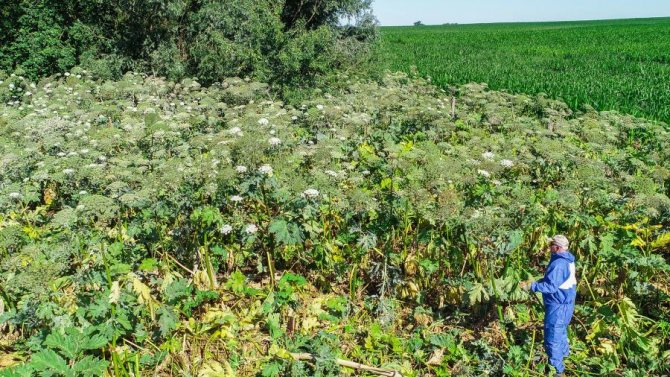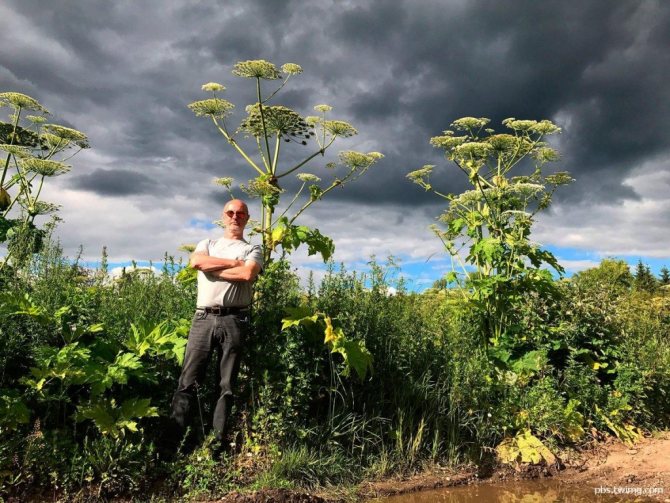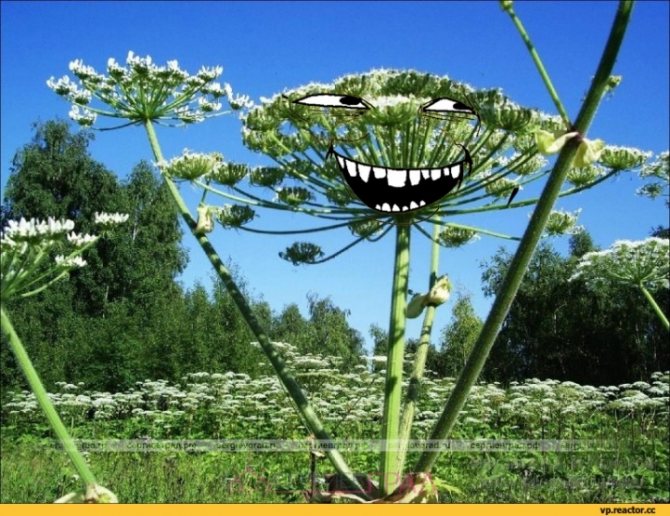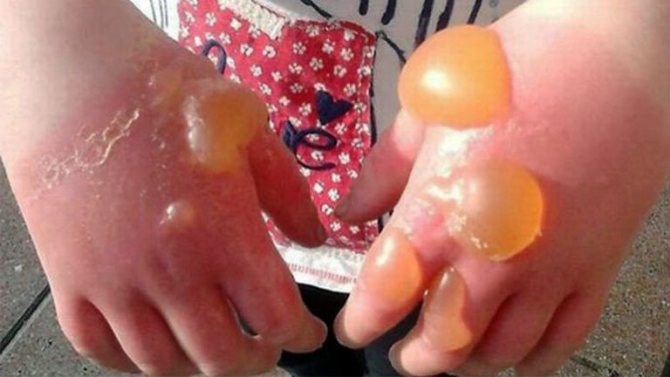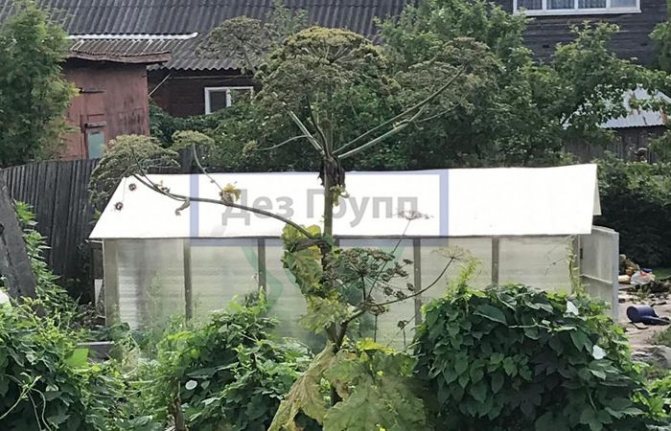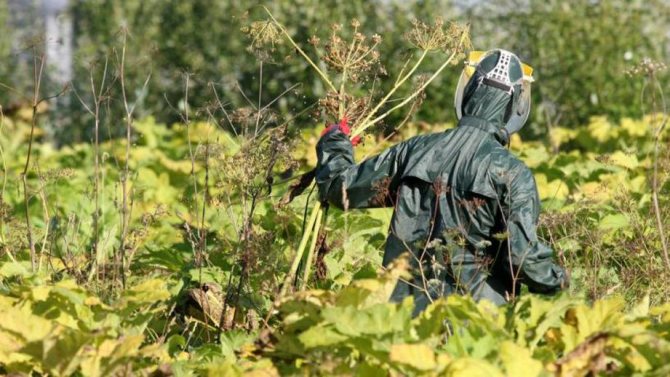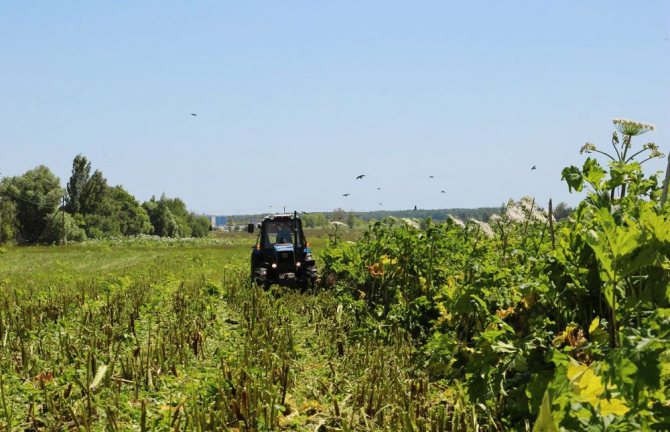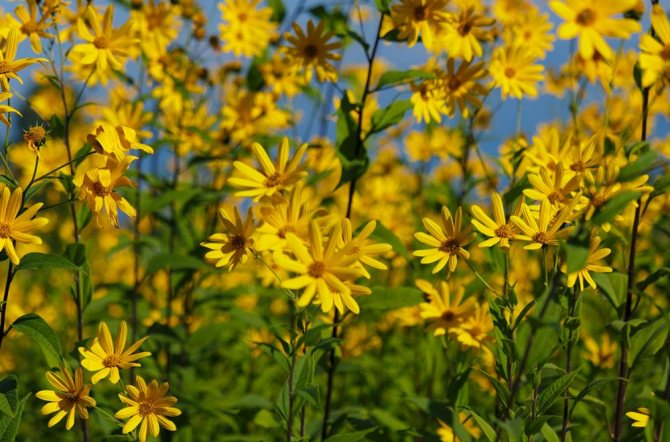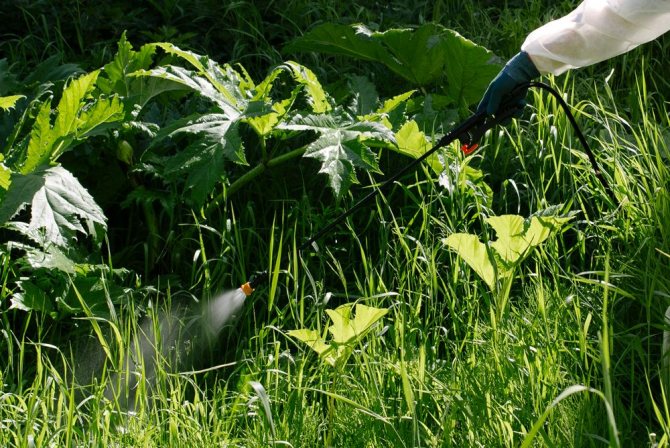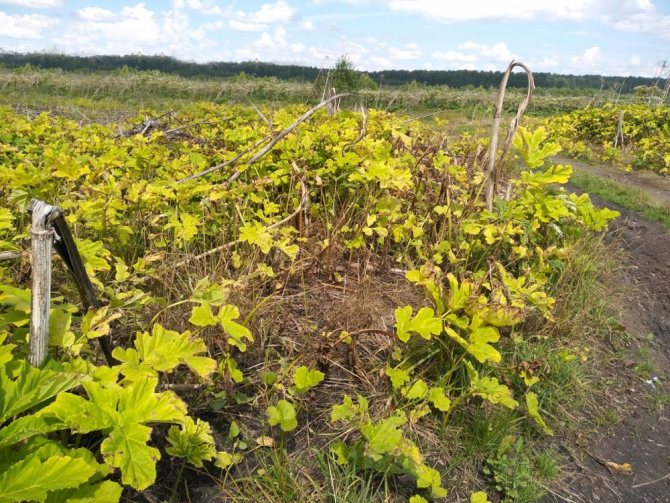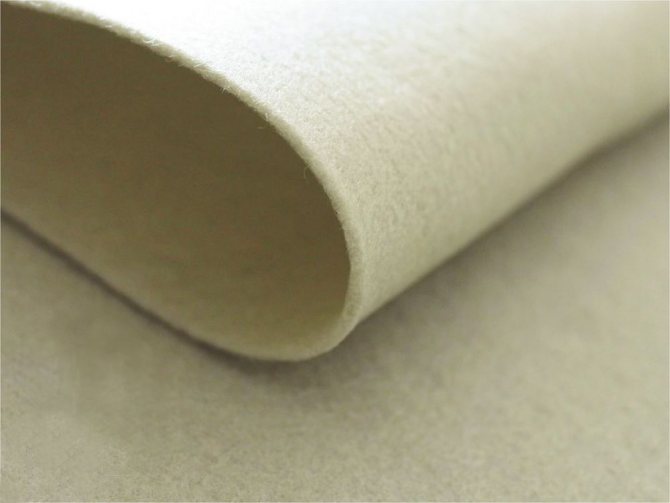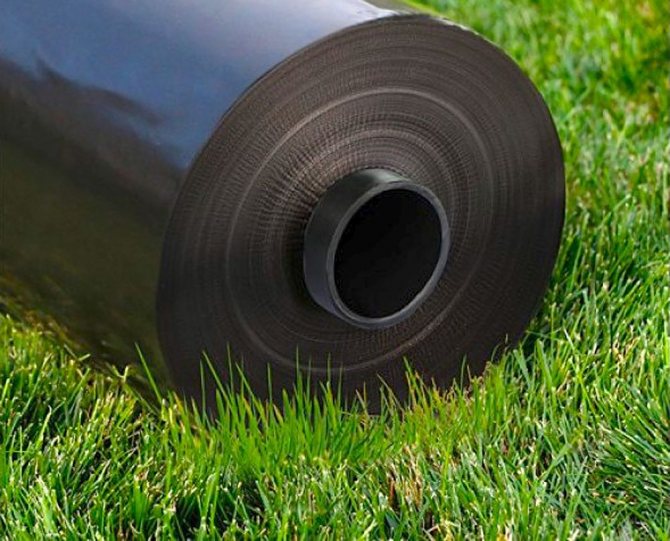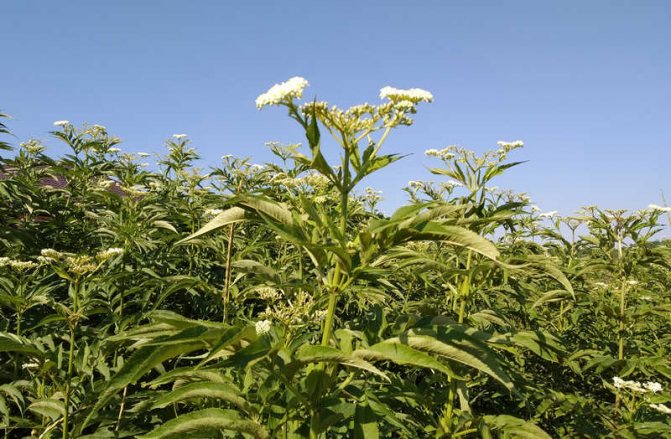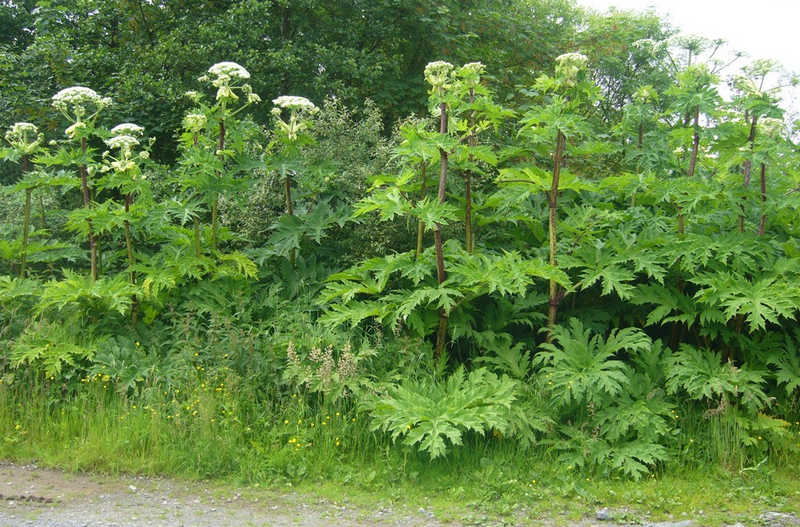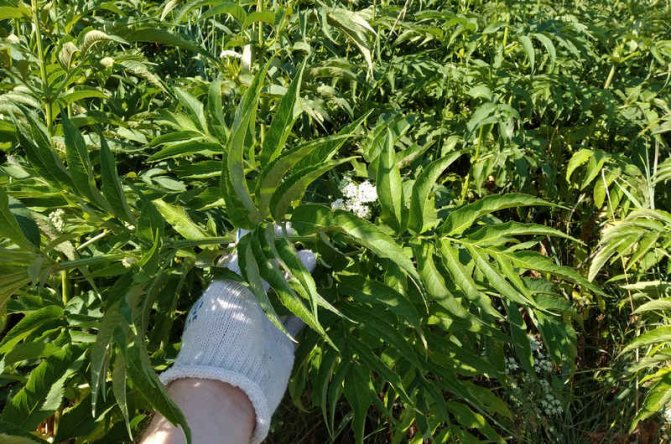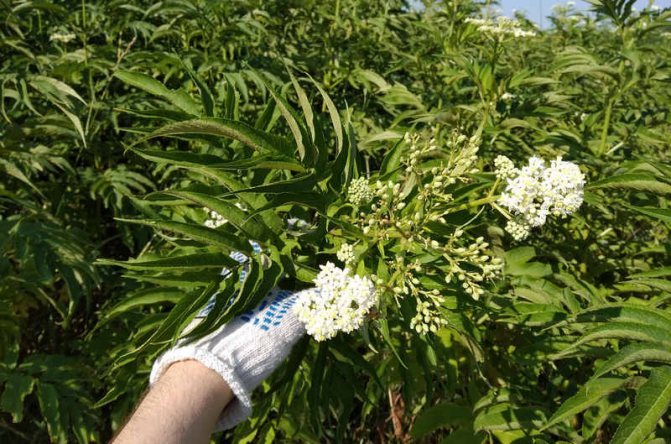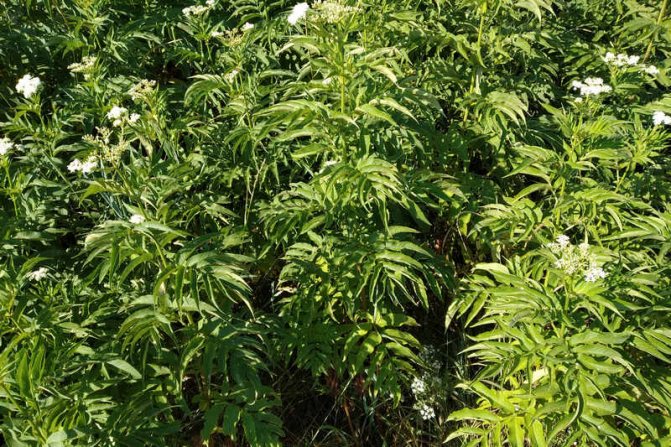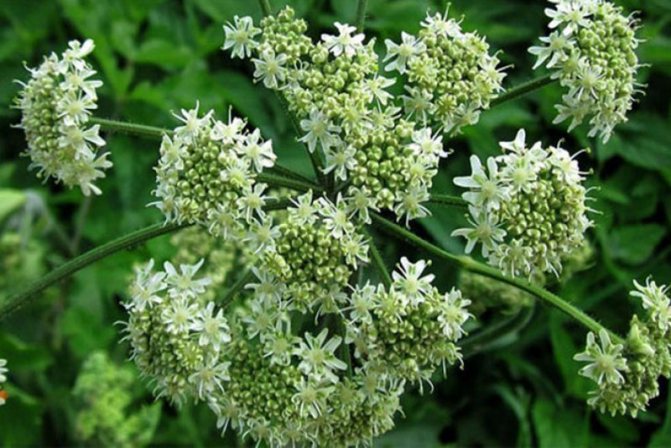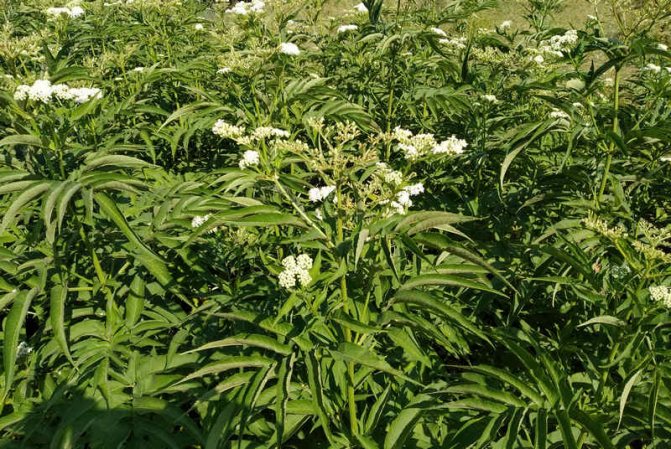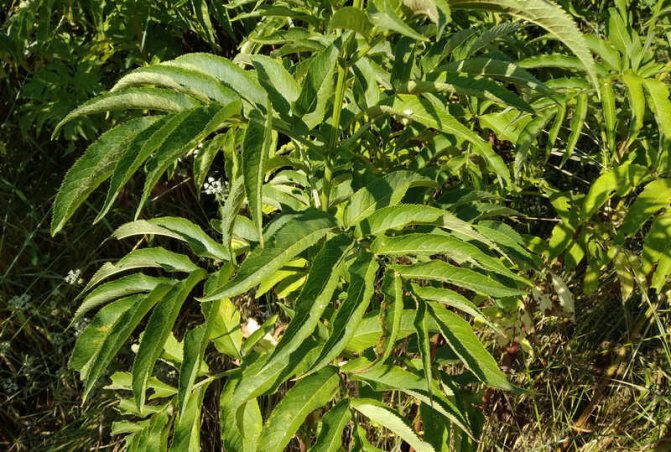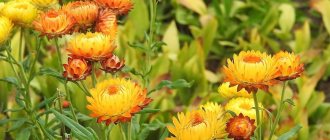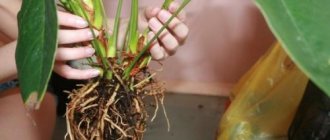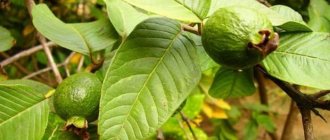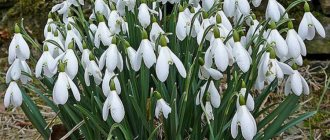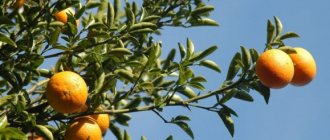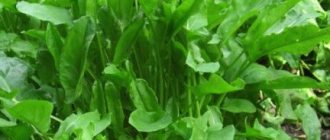Finding Sosnovsky's cow parsnip on your site is not a pleasant surprise. Dealing with this poisonous plant is not an easy task. In addition to the fact that the cow parsnip is dangerous and requires certain measures to protect against it, it is also extremely tenacious and spreads catastrophically.
- Each plant produces up to 20 thousand seeds, which are easily spread over a large area, and once in the ground, the seeds retain their germination for up to 5-10 years.
- Hogweed seeds, being in the soil, secrete special essential oils that prevent the growth of other crops.
- Very fast growth - in a day it can add up to 10 cm in height.
- Pollinated both by insects and independently
- Not afraid of frost and easily tolerates them
- If you mow a hogweed with seeds that have already begun to form, they will ripen on cut umbrellas. And if they are left on the site, then this mowing will be useless.
- Recovers without problems after mowing. It grows from a small shoot or buds dormant in the ground.
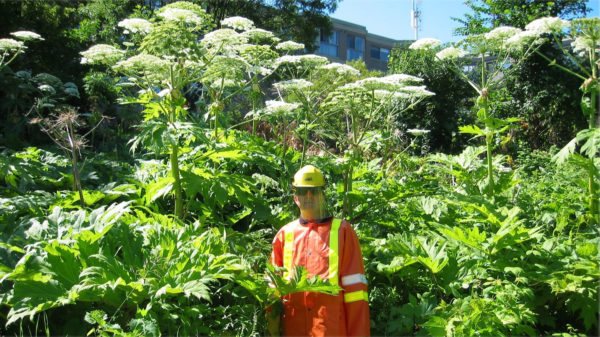
Sosnovsky's hogweed
Therefore, in order to get rid of the hogweed, you need to take decisive and systematic measures. This article will discuss ways to destroy hogweed so that you can choose the best and most suitable method for you.
First, consider weak points of the hogweed:
- Despite the fact that the hogweed can live up to several years, it blooms only once in its entire life, after which it dies.
- The hogweed is not able to recover from the remnants of the root if all dormant buds are removed.
- The hogweed is afraid of a large amount of water and does not grow in such conditions;
- Unable to grow from great depths (more than 30 cm) and needs the sun.
Important! Before proceeding with the extermination of hogweed, you need to properly protect yourself. It is required to exclude the possibility of its poisonous juice getting on your body! You should not have exposed areas of skin - everything should be securely hidden by clothing. And also be sure to use eye protection, such as special glasses. If you do get burned, you can find out about treatment in this article.
Digging up the whole plant
If there are only single specimens of hogweed in your territory, then it would be a good way to dig them up along with the root.
You need to dig it before the seeds appear - in April - May or at the very beginning of summer.


Digging up a hogweed
Armed with a bayonet shovel, it will be correct to dig to a depth of 40 cm, and dig in the roots from all sides. Then the extracted plant must be burned.
Safe views
Most of the species of this plant are still safe, and only a few of them are found on the territory of our country. As a rule, they look less threatening: they have less rigid stem and leaves, do not grow to such huge sizes.... Having met these varieties, you can safely touch them:
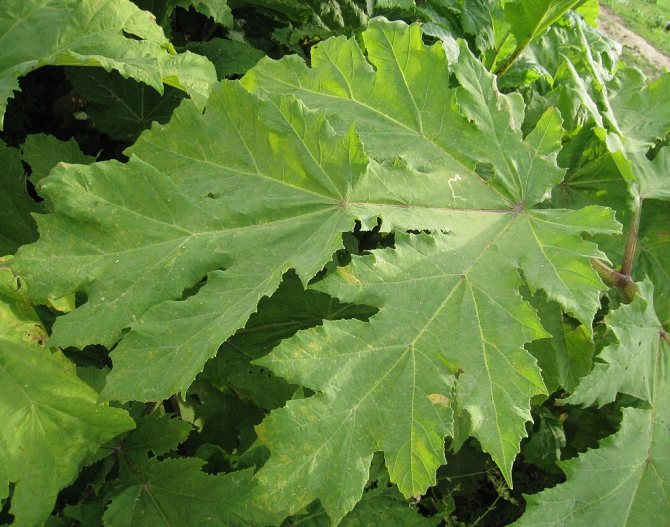

Shaggy - common in the south: in the Crimea, the Caucasus, in Asia Minor. Reaches a height of one and a half meters and blooms with white flowers.- Dissected - mainly grows in forest-steppes and on the banks of Siberian rivers, has large white flowers.
- Siberian - it can be found almost throughout Russia. It is short, covered with green-yellow flowers, and its fruits outwardly resemble an egg.
All of these species are not only safe, but also eaten and used for medicinal purposes.
Covering with foil, mulching
A reliable way to eliminate hogweed is to use a covering material. This weed, despite its hardiness, cannot grow without the sun. Therefore, the following method is often practiced:
- In May, the existing seedlings are mowed.
- The entire growing area of the hogweed is covered with a black dense film, at least 0.1 mm thick. The film is fixed around the perimeter with weights.
- The film should be in place until July next year. Then it can be removed and the given place to be planted with any crops.
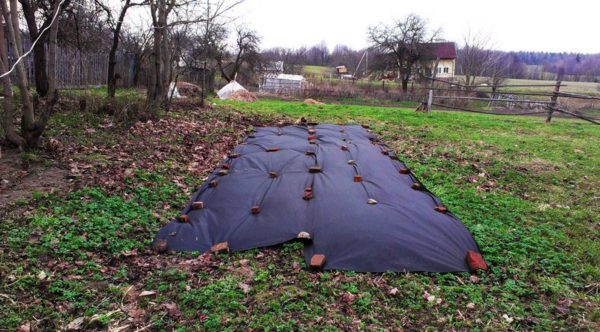

Covering with black foil
If you strictly follow the proposed plan, then in the first year the entire hogweed will die, along with the root system. And in the next, the seedlings sprouted from the seeds remaining in the ground, there will be no chance to grow without sun, water and air.
If you do not plan to grow any useful crops in the area affected by Sosnovsky hogweed, then you can use the following method:
- At the beginning of the season, the affected area is plowed up.
- Then the entire area is covered with a geotextile with a density of 100g / m3.
- Pure land is poured onto the geotextile. The soil layer should be about 5 cm.
- We sow with a grazing mixture of herbs on the prepared soil. Seeding rate 20 kg / ha.
The result of these actions will be thick grass in this area, which will not germinate the pest. This herb should be left for several years while the cow parsnip seeds remain viable.
What is hogweed and where did it come from
The cow parsnip is a plant of the umbrella family, which includes 42 species. Most of the plants in this family are not dangerous to humans. For example, such a species as Siberian hogweedcommon in Siberia and Kazakhstan, were once eaten. Some types of hogweed were used as an ornamental crop.
Sosnovsky's hogweed is a poisonous and dangerous species that currently floods large areas of our country, previously it was not considered as such. This plant began to be cultivated for livestock feed. The plant attracted farmers by the fact that it grows quickly and gains weight, is not destroyed by mowing, it grows rather quickly and has many useful substances for animals.
However, farms became smaller and smaller, and the Sosnovsky hogweed continued to grow. Now it takes up huge areas without use, which could be used for other needs. In some countries there are programs against hogweed and projects supported at the state level.
To make your site the best, we advise you to read article on the rules for feeding peonies.
Folk remedies
An interesting way using vinegar was invented by summer residents to get rid of hogweed. The umbrellas are cut and destroyed, and acetic acid is poured into the tube of the plant. Thus, the death of the plant occurs, new inflorescences do not appear. Another option - when the inflorescences have not yet formed, they can not be cut off, but simply injected with vinegar through a syringe into the stalk of the hogweed. As a result, the plant withers and dries up.
Popular experience shows that other methods of fighting against cow parsnip, such as sprinkling with salt or using other improvised means, are usually not very effective.
External appearance
The cow parsnip looks quite impressive, and knowing that it is he, it is impossible not to notice him. Depending on the species, it can reach six meters in height, but more often it is still shorter - from half a meter to one and a half meters.
The stem of this plant is usually hollow, ribbed, and can be covered with sparse or dense fluff. Branches appear closer to the top of the plant. The leaves are wide, long and smooth, covered with small villi.
During the flowering period, the hogweed can even be called beautiful. Umbrellas of small flowers appear on it - white, yellowish or pinkish. In autumn, they turn into neat boxes with seeds, which are easily carried away by the wind - this is how the plant reproduces.
Most of this genus are biennial, but sometimes perennials are also found. Nevertheless, they bloom only once in their life, after which, as a rule, they die off.
Herbicides
Chemicals are effective against hogweed. There are so many options on the market that it can be easy to get confused on first consideration. But in fact, everything is not so difficult - most weed control drugs use glyphosate as an active ingredient. The advantage of such pesticides is that they can be applied in a targeted manner. Only cow parsnip can be processed, while other plants in your garden will not be affected. Glyphosate quickly enters the root system, blocks important processes and the plant dies.
To understand which remedy has the greatest effect for the price spent, you can based on a comparison of the price and content of the active substance. Let's take a look at the comparison table.
| Means | Content of active ingredient, glyphosate | approximate price |
| Ground | 360 g / l | RUB 400 for 25 0ml |
| Roundup | 360 g / l | RUB 1,500 for 1 liter |
| Tornado | 360 g / l | 1000 RUB for 1 liter |
| Agrokiller | 500 g / l | RUB 900 for 1 liter |
| Hurricane | 500 g / l | 1000 RUB for 1 liter |
| Sniper | 36 g / l | RUB 60 for 50 ml |
To defeat the hogweed, you must adhere to the following instructions:
- In May, when the hogweed shoots are clearly visible, we spray them with a glyphosate solution. The recommended concentration is 120 ml per 10 liters of water for pesticides containing 360 g / l glyphosate.
- After about three weeks, re-treatment with the same chemistry should be carried out. Thus, surviving plants and new shoots will be treated.
- We do the third cleaning in July, water again the remaining hogweed and the sprouts that have appeared.
- In the future, in the current and subsequent years, we carry out spot treatment of the emerged plants.
In this way, in the first year, last year's plants will be destroyed and the reproduction of hogweed will be stopped. And in subsequent years, it is only required to clean up the territory from new plants that have sprouted from seeds that have already been in the soil and introduced new ones.
It can be concluded that the glyphosate treatment method is effective, but requires a lot of labor and a systematic approach. Therefore, it is not very suitable for dealing with hogweed in large areas, when the weed has captured entire fields. If the task is not to protect other vegetation from the poison, then you can use powerful poisons that work over the area. An example of such a remedy is Arbonal (the active substance is imazapir). This chemical will poison all plants and prevent new ones from germinating from seeds for 2-3 years.
The reasons for the appearance and the danger of spread
The Sosnovsky hogweed was first described in 1944 by the botanist I.P. Mandenova in Georgia. I got to the European part of Russia as ornamental plant thanks to the gigantic size and umbrellas of snow-white colors. In the future, his selection was facilitated by such unique qualities as high fodder value, winter hardiness and productivity.


At first, the specialists highly appreciated the decorative properties of the plant and its forage potential.
The low cost of cultivation and the high content of sugars and nutrients necessary for fattening farm animals turned out to be attractive. Therefore, in the postwar years, it was actively cultivated as fodder crop throughout the European part of the USSR (even on Sakhalin Island and in the present Komi Republic), as well as in modern countries of Eastern Europe, in particular in the Baltic States.
However, scientists did not pay enough attention to the toxicity of the plant, the juice of which contains biologically active substances - furocoumarins, which have photodynamic activity and increase the sensitivity of the skin to ultraviolet radiation. Hogweed juice, getting on human skin, under the influence of sunlight, causes dermatitis like chemical burns, especially if the juice gets on the mucous membrane of the eyes. Hogweed flower pollen provokes allergic reactions.
The action of furocoumarins is initially unnoticeable. After contact with the plant (it is enough to touch the leaves or stem), a burn may occur after an hour or more, and then blisters form. The more light, the more aggressive the reaction is. If hogweed juice gets on the skin, wash it with soap and water, wipe it with alcohol or cologne, avoid sunlight, keeping it out of the affected skin, and consult a doctor if necessary.
The effect of toxic substances of hogweed on animals has been little studied. When introduced into silage in large quantities, milk from agricultural cattle acquires a bitter taste and smell of essential oils.
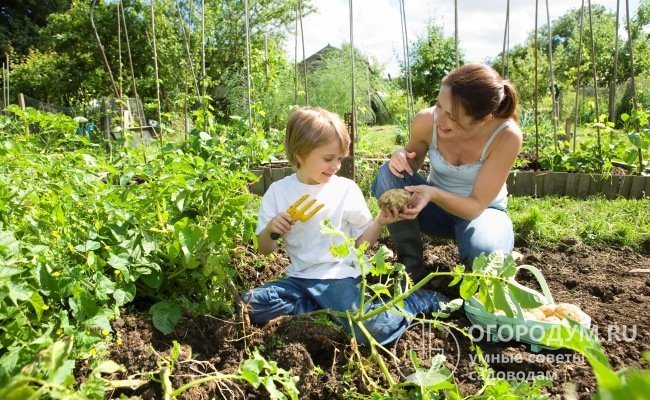

Children must be told about the poisonous properties of the plant and warned about the dangers of contact with this weed.
In the 90s of the last century, due to the collapse of the agro-industrial complex, the cultivation of hogweed Sosnovsky was no longer given due attention. As a result, the natural biological diversity of the landscape was disrupted, and there was a threat to public health. Currently, at the federal level, methods have been developed to combat this weed, including on the lands of personal household plots.
Hiring specialized firms
In many regions, it is possible to use the services of organizations to destroy hogweed in your area. When choosing a specific service to combat hogweed, you should pay attention to how this weed will be treated. Based on the material in this article, you can already judge the effectiveness of this or that method.
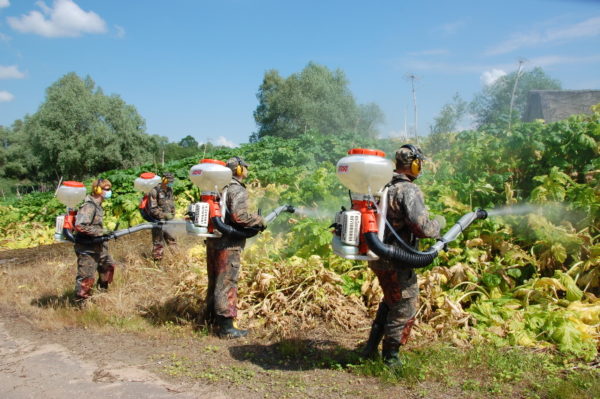

Processing by specialized firms
Regional programs for the control of hogweed
Different countries and regions have different rules and measures aimed at combating Sosnovsky hogweed and mantegatsia.
For example, in Belarus since 2009, an extensive state program has been operating, which includes the elimination of hogweed and fines for its growth in private territories.
In Tatarstan and the Kirov region, fines of up to 10 thousand for the growth of hogweed on the site have also been in effect for several years.
In the Moscow region, they are going to adopt a law by the end of 2018, according to which a fine is due for the thickets of hogweed on the site:
- up to 5000 rubles for individuals
- up to 50 thousand rubles. for officials
- from 150 thousand to 1 million rubles for legal entities
Also in the Moscow region there is a program according to which, through the Dobrodel service, you can complain and vote for plots affected by hogweed, which will be processed by the state in the first place. And also there you can simply report on new thickets of poisonous grass.
No man is an island
A resident of Balashikha, Maria Popova, has been fighting against Sosnovsky's hogweed for several years. It all started with a village on the Volga, beloved from childhood, where he comes in the summer. I somehow looked around the expanse and gasped: Tolstoukhovo was drowning in toxic thickets.
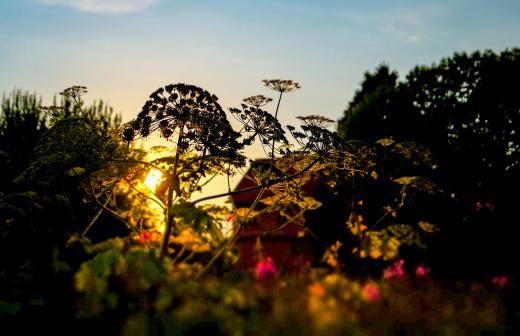

The State Duma assessed the messages of the German media about the "borshevich disaster" of Russia
“At the entrance to Kalyazin, there are absolutely scary places - cow parsnip to the horizon,” Maria tells Izvestia. She tried to explain to the neighbors that it was necessary to save the picturesque places, but to no avail. - For the first 2-3 years I practically fought alone, they looked at me as not quite healthy: "What is stopping you or what?" But I, of course, continued, because I cannot look at it calmly.People are different, someone in all seriousness has enough of their own garden for happiness: they arrived, rested, bathed in the river and left. Mostly summer residents, there are practically no locals. Someone nods: yes, how terrible everything is. And someone says: "Yes, I am already old, my back hurts." I don't even know what to answer to this, because the elderly have children and grandchildren, but for some reason they are in no hurry to help.
So Maria began a solitary confrontation, and when she returned to Balashikha, she realized: here she can only dream of peace. Waterproof clothing, shoes, gloves, a mask on the face, and in the hands of a shovel or knife. Sometimes the husband takes part in a special operation, but the children are small, there is no one to leave, so they "go to work" in turn. Maria's "digging" suffering begins when the cow parsnip has not yet grown to its full height, and so, ankle-deep - in late April - early May.
Hogweed
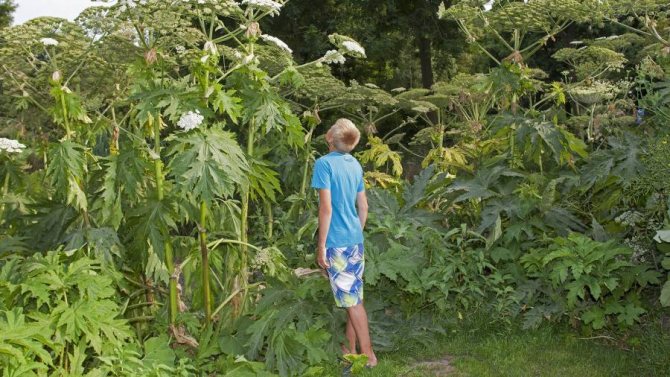

Photo: Global Look Press / blickwinkel / F. Hecker
- Last year in a neighboring area there was a man who went out with me on a "hunt". The first of the closest neighbors, says Maria, but warns: the main thing is to observe safety precautions. - I decided to take a look - lifted the sleeve with a dirty glove ... I don't do that anymore. The burn was small, did not appear immediately, but it took a long time and was disgusting.
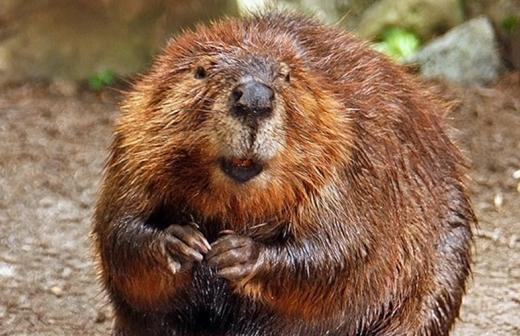

Canadian beaver and Georgian hogweed threaten the ecology of Russia
Dozens of plants and animals are included in the catalog of alien biological species dangerous for the country
Now Maria is trying to organize a subbotnik in Losiny Island - the hogweed has already taken root there. Chemicals cannot be used here (after all, the National Park), you cannot drive a tractor - the weed has occupied the places along the river. She could have - she herself began to put things in order, but two hands for the whole National Park is not enough.
“Unfortunately, a lot of time passes between understanding the problem and taking action, and time is very expensive here, the later one realizes it, the more resources will be needed,” Maria explains. A mathematician and programmer, she is no worse than a botanist versed in the insidious weed. She created a website against the hogweed Sosnovsky, maintains a page on the social network - exchanges advice, monitors news.
- There are many species of hogweed, some edible, differ in size, shape of leaves. Once I went for a walk in Balashikha nearby, I saw: someone furiously uprooted an angelica (a medicinal plant - Ed.). I went on - again the angelica was torn out. I had to write an article on recognizing the hogweed. What about? Angelica, too, with an umbrella, also tall, and the fact that the shape of the leaf is different, unfortunately, they do not look at it.

